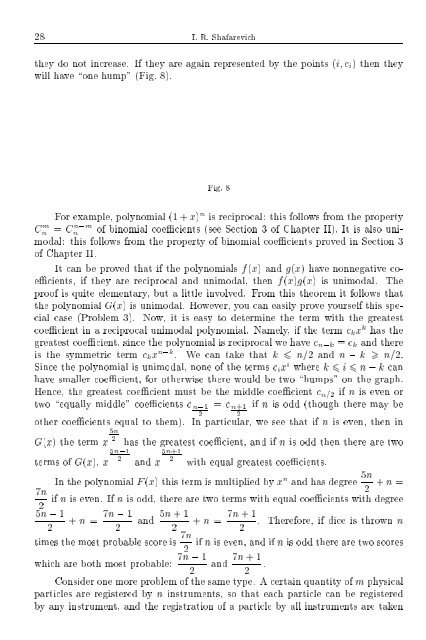28 I. R. <strong>Shafarevich</strong>they do not increase. If they are again represented by the points (i c i ) then theywill have \one hump" (Fig. 8).Fig. 8For example, polynomial (1 + x) n is reciprocal: this follows from the propertyCnm = Cn;m n of binomial coecients (see Section 3 of Chapter II). It is also unimodal:this follows from the property of binomial coecients proved in Section 3of Chapter II.It can be proved that if the polynomials f(x) andg(x) have nonnegative coecients,if they are reciprocal and unimodal, then f(x)g(x) is unimodal. Theproof is quite elementary, but a little involved. From this theorem it follows thatthe polynomial G(x) is unimodal. However, you can easily prove yourself this specialcase (Problem 3). Now, it is easy to determine the term with the greatestcoecient in a reciprocal unimodal polynomial. Namely, if the term c k x k has thegreatest coecient, since the polynomial is reciprocal we have c n;k = c k and thereis the symmetric term c k x n;k . We can take that k 6 n=2 and n ; k > n=2.Since the polynomial is unimodal, none of the terms c i x i where k 6 i 6 n ; k canhave smaller coecient, for otherwise there would be two \humps" on the graph.Hence, the greatest coecient must be the middle coecient c n=2 if n is even ortwo \equally middle" coecients c n;1 = c n+1 if n is odd (though there may be22other coecients equal to them). In particular, we see that if n is even, then inG(x) the term xterms of G(x), x5n2 has the greatest coecient, and if n is odd then there are two5n;125n+12and xwith equal greatest coecients.In the polynomial F (x) this term is multiplied by x n and has degree 5n7n2 + n =if n is even. If n is odd, there are two terms with equal coecients with degree25n ; 1+ n = 7n ; 1 5n +1 7n +1and + n = . Therefore, if dice is thrown n22 22times the most probable score is 7n if n is even, and if n is odd there are two scores2which are both most probable: 7n ; 1 7n +1and .2 2Consider one more problem of the same type. A certain quantity ofm physicalparticles are registered by n instruments, so that each particle can be registeredby any instrument, and the registration of a particle by all instruments are taken
Selected chapters from algebra 29to be equally probable. What is the probability that all instruments register atleast one particle? An elementary event here is the registration of a particle by aninstrument. Let the instruments be denoted by the elements a of the set M. Wehave n(M) =n. Numerate the particles by1,2,... ,m. Then an elementary eventis the sequence (a 1 ...a m ) where a i 2 M and this sequence indicates that the i-thparticle is registered by theinstrument a i . In other words, the set of elementaryevents is M m in the sense of the denition given in Section 1. The condition ofthe problem states that all elementary events have equal probabilities. Since byTheorem 1, n(M m )=n m , the probability of each elementary event is1=n m . Weare interested in the subset N M m which contains the sequences (a 1 ...a m )inwhich all the elements of M appear. For example, if M = fa b cg, m =4,then(a b c a) 2 N, but the sequence (a b a b) does not belong to N, since it does notcontain c. Our problem is to nd n(N).Denote by M a the subset of M m which consists of the sequences (a 1 ...a m )in which none of the a i 's is equal to a. Then clearly N = S M a , i.e. N is thecomplement of the union of all sets M a for all a 2 M. Therefore, n(N) =n(M m );n( S M a ) and the values of the numbers n( S M a ) are given by formula (21). Let usnd the number n(M a1 \ M a2 \\M ar ), where a 1 , ... , a r are dierent elementsof the set M. Hence, we are dealing with the sequences (c 1 ...c m )inwhichnoneof the c i 's equals any ofa 1 ,...,a r . In other words, c i are arbitrary elements of theset fa 1 ...a r g, where fa 1 ...a r g is the complement offa 1 ...a r g with respectto M. The set of all such sequences is the set (fa 1 ...a r g) m and the number ofelements of this set is, by Theorem 1, (n(fa 1 ...a r g)) m . Since n(fa 1 ...a r g)=r,n(M) =n, wehave n(fa 1 ...a r g)=n;r and n(M a1 \M a2 \\M ar )=(n;r) m .Hence, each term n(M i1 \ M i2 \\M ir )informula (21) in our case is (n;r) m .The number of terms for a given r is equal to C r n,asweknow. Therefore, formula(21) givesn( [ M a )=C 1 n(n ; 1) m ; C 2 n(n ; 2) m + +(;1) n C n;1n 1 m :For N = S M a we obtainn(N) =n(M m ) ; n( [ M a )=n m ; C 1 n (n ; 1)m + +(;1) n;1 C n;1n 1 m :The requested probability isn(N)(31)=1; n ; 1n m C1 nn m m 1+ +(;1) n;1 Cnn;1 :nIn all the previous examples elementary events had equal probabilities 1=n,where n is the number of elementary events. As a result, the evaluation of probabilitiesof other events reduced to the counting of the number of subsets|i.e.to a problem of combinatorics. We shall now consider examples which are morecharacteristic for the theory of probability.Let (Mp) and (Nq) betwo probability schemes. Suppose that they are de-ned by many times repeated experiments|dierent experiment for each scheme.
















